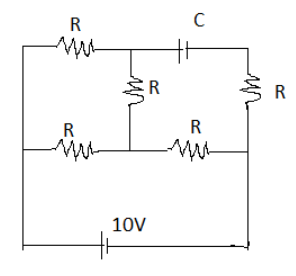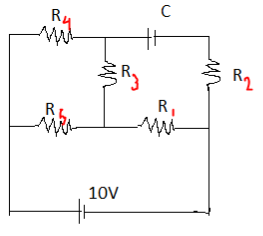
Find the potential difference across the capacitor in volts

(A) 7
(B) 8
(C) 9
(D) 10

Answer
573k+ views
Hint: We firstly need to calculate the equivalent resistance of the circuit by neglecting the capacitor. After calculation of the equivalent resistance of the circuit, we calculate the current in the current following Ohm's law. Further we can calculate the potential at different points and thus the potential difference across the capacitor.
Formula used: V=IR
Complete answer:
Firstly, we neglect the capacitor and calculate the value of equivalent resistance of the entire circuit.

The resistors 1 and 2 are connected in series which gives us an equivalent resistance of 2R. Again the equivalent resistance is in parallel with 3, whose combination gives us a value of 2R/3. The 2 resistors 5 and 6 are in parallel. So the total value of resistance is 5R/3 Ohm.
Now, using Ohm’s law, we calculate the current flowing through the entire circuit
\[\begin{align}
& V=IR \\
& \Rightarrow I=\dfrac{10}{{5R}/{3}\;} \\
& \Rightarrow I=6A \\
\end{align}\]
Thus, potential at the left end of the capacitor= (10-2) V
Potential at the right end of the capacitor=0 V
$\therefore $ The potential difference across the capacitor in volts is given as (B)8V.
Additional Information:
The equivalent resistance of the series combination is calculated as:
${{R}_{eq}}={{R}_{1}}+{{R}_{2}}$, for any two resistors in series having resistance ${{R}_{1}}$ and ${{R}_{2}}$
The equivalent resistance of the parallel combination is calculated as:
$\dfrac{1}{{{R}_{eq}}}=\dfrac{1}{{{R}_{1}}}+\dfrac{1}{{{R}_{2}}}$ , for any two resistors in parallel having resistance ${{R}_{1}}$ and ${{R}_{2}}$.
Note:
This problem can also be approached with Kirchhoff’s circuit laws for voltage and current after calculation of equivalent voltage of the circuit directly. That might be a more convenient approach for some. But the signs of current must be kept in mind while taking that approach.
Formula used: V=IR
Complete answer:
Firstly, we neglect the capacitor and calculate the value of equivalent resistance of the entire circuit.

The resistors 1 and 2 are connected in series which gives us an equivalent resistance of 2R. Again the equivalent resistance is in parallel with 3, whose combination gives us a value of 2R/3. The 2 resistors 5 and 6 are in parallel. So the total value of resistance is 5R/3 Ohm.
Now, using Ohm’s law, we calculate the current flowing through the entire circuit
\[\begin{align}
& V=IR \\
& \Rightarrow I=\dfrac{10}{{5R}/{3}\;} \\
& \Rightarrow I=6A \\
\end{align}\]
Thus, potential at the left end of the capacitor= (10-2) V
Potential at the right end of the capacitor=0 V
$\therefore $ The potential difference across the capacitor in volts is given as (B)8V.
Additional Information:
The equivalent resistance of the series combination is calculated as:
${{R}_{eq}}={{R}_{1}}+{{R}_{2}}$, for any two resistors in series having resistance ${{R}_{1}}$ and ${{R}_{2}}$
The equivalent resistance of the parallel combination is calculated as:
$\dfrac{1}{{{R}_{eq}}}=\dfrac{1}{{{R}_{1}}}+\dfrac{1}{{{R}_{2}}}$ , for any two resistors in parallel having resistance ${{R}_{1}}$ and ${{R}_{2}}$.
Note:
This problem can also be approached with Kirchhoff’s circuit laws for voltage and current after calculation of equivalent voltage of the circuit directly. That might be a more convenient approach for some. But the signs of current must be kept in mind while taking that approach.
Recently Updated Pages
Master Class 12 English: Engaging Questions & Answers for Success

Master Class 12 Economics: Engaging Questions & Answers for Success

Master Class 12 Social Science: Engaging Questions & Answers for Success

Master Class 12 Maths: Engaging Questions & Answers for Success

Master Class 12 Chemistry: Engaging Questions & Answers for Success

Master Class 12 Business Studies: Engaging Questions & Answers for Success

Trending doubts
What are the major means of transport Explain each class 12 social science CBSE

Which are the Top 10 Largest Countries of the World?

Draw a labelled sketch of the human eye class 12 physics CBSE

Explain sex determination in humans with line diag class 12 biology CBSE

The pH of the pancreatic juice is A 64 B 86 C 120 D class 12 biology CBSE

Explain sex determination in humans with the help of class 12 biology CBSE




